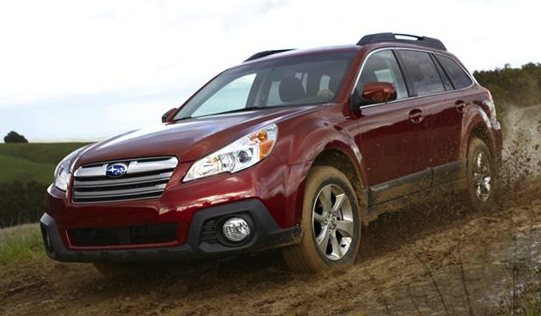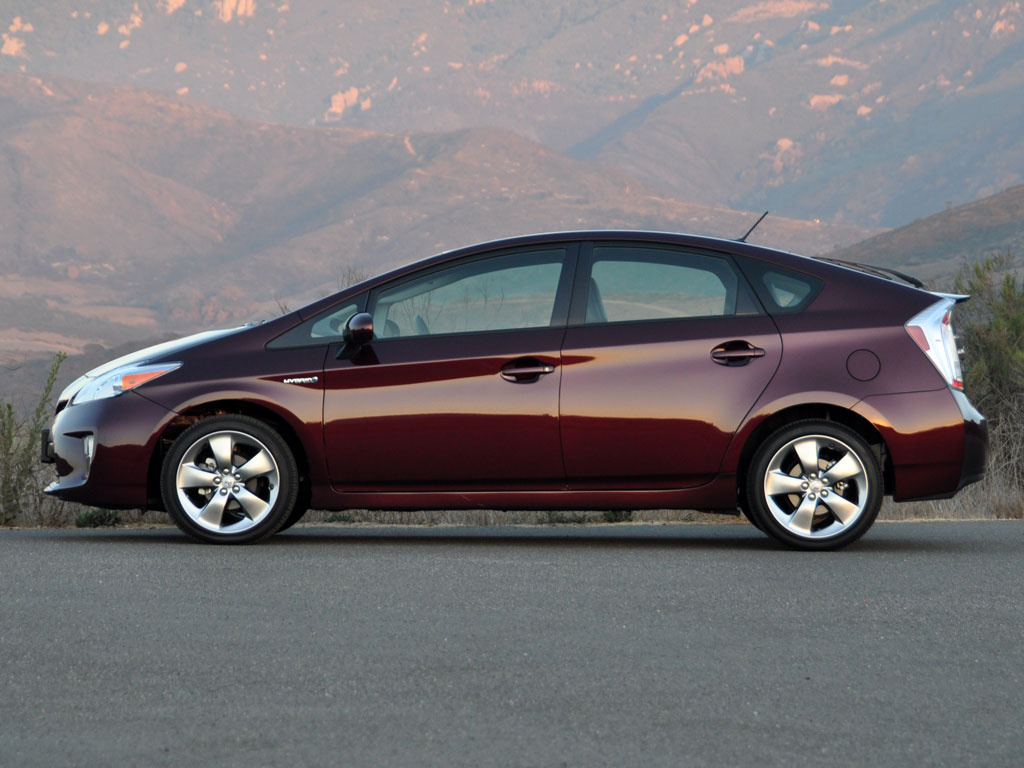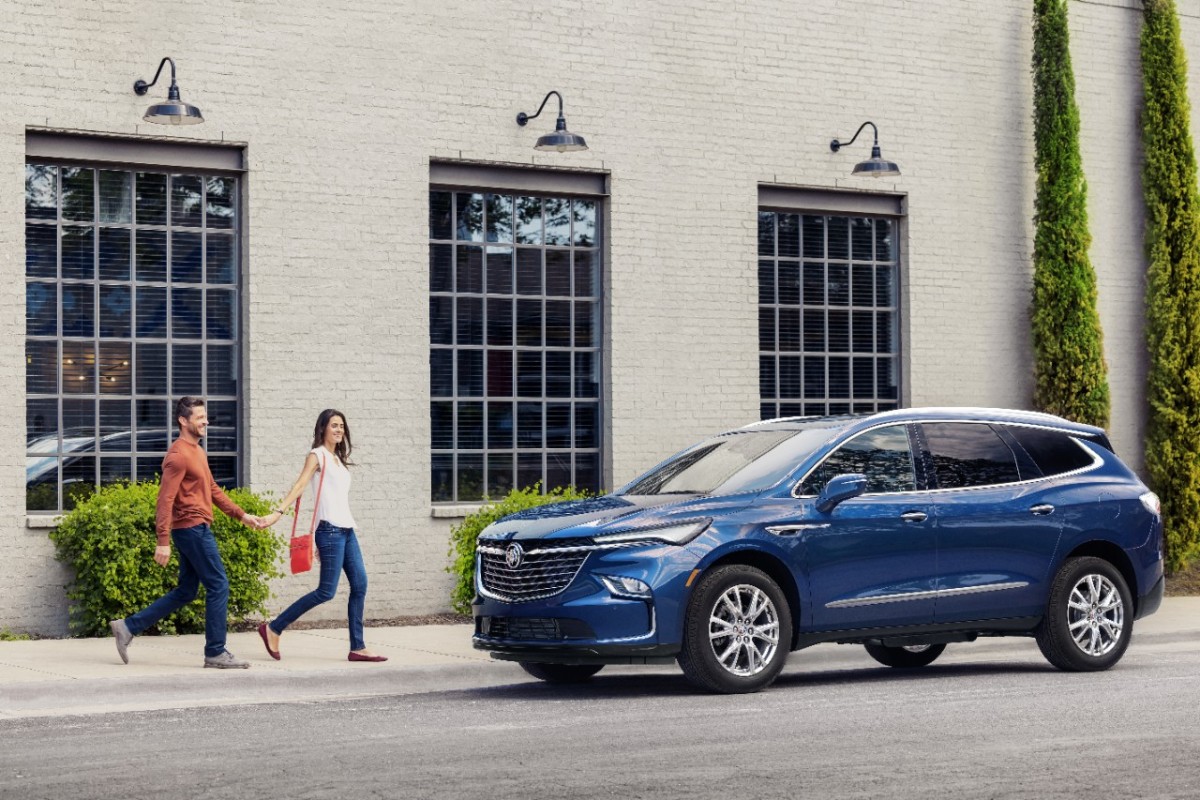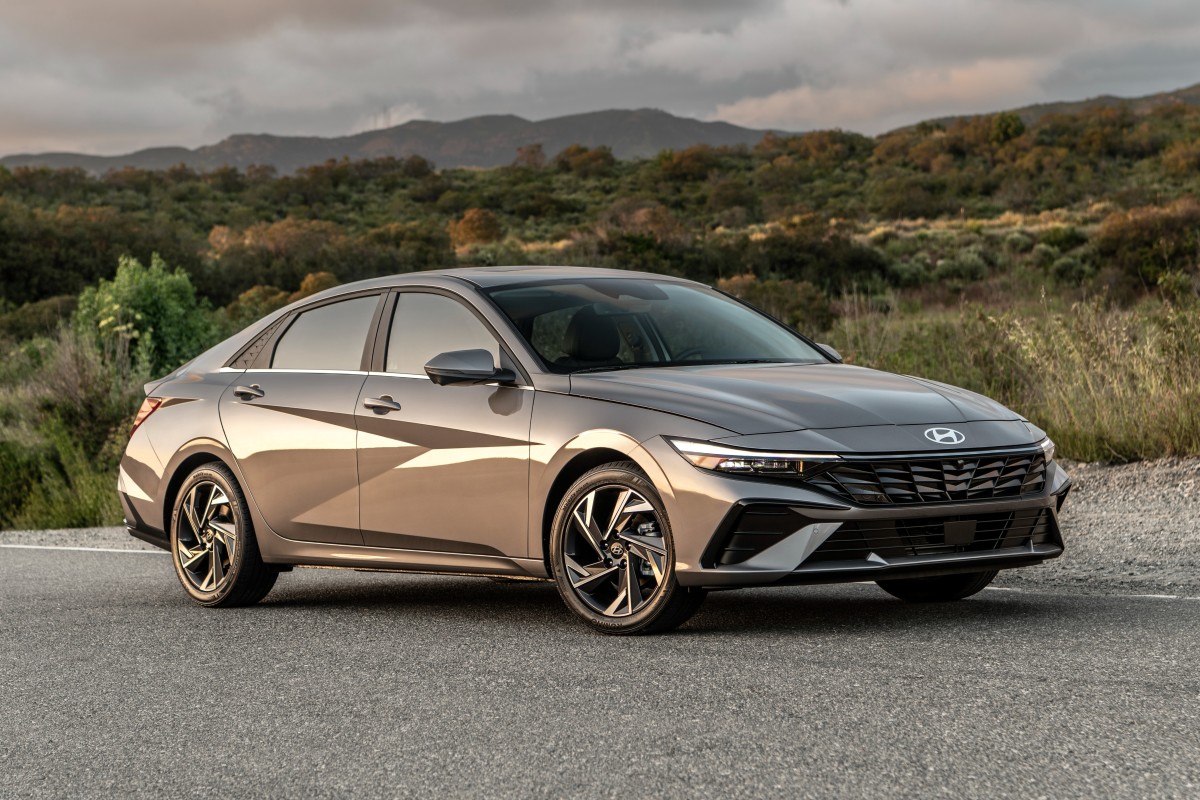These days the Subaru Outback is called a crossover, but it wasn’t always that way. The Outback originally began as an option package on the midsize Subaru Legacy way back in 1995, and it once came as a sedan in addition to its familiar wagon-turned-SUV shape. A pioneer in the field, Subaru had begun offering all-wheel drive (AWD) cars 20 years earlier, and when sales slumped in the late 1980s and early 1990s, it mined that history to reinvent its lineup. The Outback was one of the first results.
Though the very first Outback was a more rugged-looking AWD Legacy wagon, within a year, it had a lift kit for extra ground clearance. After that, the recipe was simple. Take the capable AWD system the Legacy already had, add ground clearance and suspension refinements, and make it look good. The model’s introduction came just as American consumers’ appetite for SUVs had reached a fever pitch, and while still fundamentally a wagon, the Outback cast off notions of traditional family haulers in favor of a go-anywhere road trip image.
The Outback was immediately popular and soon spawned the smaller Outback Sport, based on the compact Impreza. In its first decade, there was also a matching sedan, the Legacy SUS (Sport Utility Sedan), often badged as an Outback. The Outbacks were so popular, and AWD such a good differentiator, that by 1999, Subaru had made its entire lineup AWD and leaned heavily into the Outback’s popularity.
Since then, the Outback has grown ever further away from the Legacy, with its larger wagon body evolving into something much closer to a crossover. The result, by the late 2010s, was that the Legacy sedan’s design was dictated by the hyper-popular Outback’s off-road and space demands.
As Subaru’s biggest vehicle for many years, the Outback has often been a leader in showing off the automaker’s new technology. It’s EyeSight suite of driver-assist gear came to the model in 2008, long before some competitors from the likes of Nissan and Honda offered anything similar, and its AWD system has been consistently refined over the years. Subaru also launched an even more rugged version in 2021, the Outback Wilderness, which heralded Wilderness trims for the Subaru Forester and Subaru Crosstrek. Outbacks are practical, roomy, and highly capable as light off-road companions, with generous ground clearance and sophisticated terrain systems.
It isn’t without foibles, however. Not everyone likes the continuously variable automatic transmissions (CVTs) that Subaru has used for the past decade, and they can be complex to repair. Subaru’s flat-four and flat-six engines require more maintenance than some competitors’ conventional designs and are known for eating up head gaskets over time. They also use more gas than some conventional inline fours and V6s, and Subaru has never offered a hybrid Outback. Plus, there are simply more components to wear out in an AWD car that’s regularly used off-road than in a conventional sedan or wagon.
That said, the Outback is safe, capable, and it inspires strong loyalty in Subaru owners, who consider it a great car. This buyer’s guide breaks down each generation and included a little bit of buying advice for each.
Subaru Outback: Cost, Reliability, and the Best Years to Buy
- Frequently Asked Questions
- Subaru Outback Pros and Cons
- Subaru Outback Generations
- Sixth generation (2020-present)
- Fifth generation (2015-2019)
- Fourth generation (2010-2014)
- Third generation (2005-2009)
- Second generation (2000-2004)
- First generation (1995-1999)
Frequently Asked Questions
Which Subaru Outback years are the best?
Most Outbacks only have “average” reliability ratings from outlets that track this data. This might be because they generally need a little more maintenance than Toyota Camrys or RAV4s, and often eventually need head gasket and or timing belt replacements, both expensive jobs. However, the Outback is generally a hard-wearing vehicle. The ones with the fewest issues and the best reliability records, according to most outlets, are 2014, 2016, 2017, and 2021 and newer models, according to Consumer Reports.
What are the worst Subaru Outback years?
Different reliability tracking outlets disagree on this. CarComplaints, a crowdsourced site, find 2013, 2015, and 2018 models to have the most issues. These years overlap two generations, but the most common complaints are electrical system and engine issues. However, as indicated above, J.D. Power and Consumer Reports rate these years much more highly, and instead, the latter seems to have the most concern with 2005 to 2007 models and, more recently, 2019 and 2020 Outbacks. J.D. Power gives nearly every Outback an “average” reliability rating or just above. Few buyers will be looking for pre-2002 models, but their 2.5-liter powertrains have a track record of head gasket failures and coolant leaks.
Is a used Subaru Outback a good deal?
As a used car, the Outback can be a great deal if you’re looking for room, features, and all-weather capability. It does have higher maintenance costs than some other midsize family vehicles (sedans and crossovers), but it has also offered lots of advanced safety equipment and good driving dynamics for many years. With wagons having largely become very expensive niche items in the automotive industry, the Outback is now one of the few affordable vehicles that still uses this format, even if it has grown into a crossover-shaped machine. It’s exceedingly practical, and there’s lots of value in that.
Subaru Outback Pros and Cons
Pros:
- Great all-wheel drive system
- Comfortable, roomy interior
- Lots of safety features
Cons:
- Require costlier long-term maintenance than rivals
- Worse fuel mileage than some alternatives
- So-so on-road performance in later years
Subaru Outback Generations
Sixth generation (2020-present)
The sixth-generation Subaru Outback debuted for the 2020 model year, and while the new car was hard to distinguish from its predecessor on the outside, it boasted major technical upgrades under the surface.
Firstly, the formerly optional six-cylinder engine was eliminated in favor of a new 2.4-liter turbocharged four-cylinder. With 260 horsepower and 277 pound-feet of torque, the “XT” (reviving a name from the third-generation Outback) is more powerful and fuel-efficient than the old six (up to 26 mpg combined versus 22 before). Standard models use a revamped 2.5-liter four-cylinder engine with 182 horsepower and 176 pound-feet of torque. Both engines use a new continuously variable transmission (CVT) with an eight-speed manual shift mode, and AWD is still standard.
This generation's Outback was initially offered in seven trim levels: 2.5i, Premium, Limited, Touring, Onyx Edition XT, Limited XT, and Touring XT. Those latter models get the turbo and more equipment.
The new Outback’s in-car technology offerings also got a major overhaul, including a new available 11.6-inch, portrait-style touchscreen with Apple CarPlay and Android Auto functionality, Subaru’s EyeSight suite of safety features, a driver-distraction warning system, high-beam assist, and a front-view camera. Base models make do with a pair of stacked eight-inch screens and a more basic interface. A Wi-Fi hotspot was also available for the first time in an Outback.
The 2022 model year saw the debut of a very new and different trim, the Outback Wilderness. The Wilderness is the most off-road capable factory-issue Outback with 9.5 inches of ground clearance, Yokohama Geolander all-terrain tires, and specially tuned suspension and terrain systems. It also had looks to match, with bold plastic cladding and gold accents, special bumpers that help approach and departure angles, a new roof rail system capable of supporting 700 pounds of stuff, and water-repellent interior upholstery. It doesn’t get all of the luxury features on the Limited XT and Touring XT models, but it does get the turbocharged engine standard.
The 2023 Subaru Outback got a major cosmetic refresh, with new black cladding and a revised front fascia, both inspired by the popular Wilderness. In-car cameras are upgraded for the EyeSight system, and availability of the turbocharged engine was expanded. The Outback becomes the first Subaru to integrate what3words, a mapping technology that uses three words instead of traditional addresses or navigational points to refer to a location. Subaru has made few changes to the Outback since then.
The starting price for the 2020 model was $26,645, not including destination fees, and amazingly, the automaker has held its base price to just $28,895 for 2024 at the time of this writing. This makes the Outback one of the least expensive ways to get into a vehicle of this size and capability. It also includes many active-safety systems that cost extra on some much more expensive vehicles, so even if you choose the base model with the two oddball infotainment screens, it’s a good deal.
These sixth-generation Outbacks are still quite new and they hold their value, but they’re still a decent deal. The minimum cost of entry is $19,000, and that’ll only buy you a used base model, but 2.5-liter non-turbo Premium and Limited models can be had for $20,000 to $25,000 in great shape. Turbocharged models are much more satisfying to drive on the road, and they generally cost more, roughly $25,000 to $33,000 depending on model and year. The Wilderness is the most capable and desirable model in this group, but it's also the priciest, and expect to pay $33,000 or more for one.
CarGurus has reviewed this latest generation of the Subaru Outback multiple times, giving it a 7.7 out of 10 in 2020, a 7.8 in 2021, and a 7.5 in 2022 (for the Wilderness version).
Fifth generation (2015-2019)
The fifth-generation Outback debuted for 2015 in Standard, Premium, Limited 2.5, and 3.6R Limited trims. The styling was evolutionary, a little sportier and more aerodynamic than before but not too different, and Subaru now officially designated the Outback as a crossover rather than a wagon. The manual transmission, a staple of earlier Outbacks but rarely ordered, was dropped altogether, while more previously optional safety systems, such as automatic emergency braking and blind spot assist, became standard on more (but not all) trims.
A 2.5-liter four-cylinder engine good for 175 horsepower and 174 pound-feet of torque was standard, and this is the engine you’ll find in the vast majority of used Outbacks. The 3.6R Limited trim level got a 3.6-liter six-cylinder engine pushing out 256 horsepower and 247 pound-feet of torque. It was faster, but its 22 mpg combined fuel economy and higher price meant it wasn’t very popular.
As before, AWD was standard, and as in the fourth generation’s later years, so was a continuously variable transmission (CVT) with a six-speed manual shift mode. To help out in slippery situations, Subaru’s extra-sensitive X-Mode terrain system was now standard, as were hill-descent control and hill-start assist. The Limited trims gained exclusive Stablex suspension dampers for a firmer, more controlled ride. More importantly, all Outbacks got a new double-wishbone rear suspension design and a front suspension cradle, which meant a much smoother and quieter ride.
In the cabin, the interior got a style upgrade but only modest changes to its infotainment setup. A 6.2-inch screen was standard on the base model and a seven-inch unit was used on the higher trims, both running an easy-to-use but basic interface. In 2016, Subaru added Starlink connected services to the upper trims and added lane-keep assist to EyeSight. A year later, it updated the interior and fitted a new standard 6.5 and optional 8-inch infotainment screens running better software with nicer graphics. The latter ran Apple CarPlay and Android Auto for the first time.
The EyeSight suite of driver-assist technology was only available on upper trims and included adaptive cruise control, automatic emergency braking, and lane-departure warning. Blind-spot monitoring, lane-change assist, and rear cross-traffic alert were also reserved for upper trims until 2019. That year, the entire suite became standard across the Outback lineup.
Most gripes about this version of the Outback center on its droney CVT, which can feel listless on the highway—take a test drive to see what you think—and still doesn’t return the greatest fuel mileage. However, it’s a generally quieter and more refined vehicle than earlier versions, and tends to be trouble free apart from some issues that are common to all Outbacks. It’s comfortable and capacious, with a little more back seat space than before, and very much a known quantity as it isn’t all that different from the previous model.
Higher trims are better buys as they include the optional EyeSight gear, and buyers might also want to look at 2019 models for that same reason. The whole suite, including adaptive cruise control, was standard in that final year. All but the very best and lowest-mileage fifth-generation Outbacks can be bought for less than $25,000 now, but they do hold their value. Despite big differences in equipment, the vast majority of models sell for $16,000 to $24,000, including the more powerful 3.6R models. Finding a low-end one with less than 80,000 miles for well under $20,000 should be possible.
Fourth generation (2010-2014)
The fourth-generation Subaru Outback marked the first truly major departures from previous versions. No Outback sedan was offered and conventional automatics were eliminated on the four-cylinder models in favor of continuously variable automatic transmissions (CVTs).
The styling also grew much more crossover-like, setting a template that the fifth and sixth-generation models have closely followed. For that reason, these decade-plus-old models still look very contemporary parked next to newer Outbacks. The fourth-gen Outback was taller overall than its predecessor and weighed a little more, which hindered handling and also added weight. It got a longer wheelbase and an expanded width, which helped add interior space, but it was actually shorter overall than the 2009 model.
Much of the basic mechanical recipe remained the same. AWD was standard, with terrain modes and excellent traction, and there were four- and six-cylinder models, both updated versions of the horizontally-opposed engine families used in previous Outbacks. For 2010, the Outback came in six trim levels: 2.5i, 2.5i Premium, 2.5i Limited, 3.6R, 3.6R Premium, and 3.6R Limited.
A 2.5-liter naturally-aspirated four-cylinder engine was standard and good for 170 horsepower and an equal amount of torque. The available 3.6-liter flat-six engine made 256 horsepower and 247 pound-feet of torque. Both engines could be ordered with a six-speed manual, but the four-cylinder models (the vast majority of sales) usually used the new Lineartronic CVT. Six-cylinder Outbacks still offered a conventional five-speed automatic option.
In-car technology was still pretty basic, but Subaru did at least offer navigation and a backup camera, both running on an 8-inch touchscreen long before screens that were large were normal. It wasn’t standard, but traction and stability control were.
There were no major updates for 2011 or 2012, but 2013 brought big changes for the Outback. A restyled front fascia updated the car’s looks, while a new 2.5-liter four-cylinder engine upped the power to 173 ponies and 174 pound-feet of torque. Subaru also tailored its all-wheel drive system to each transmission, so the manual gearbox got a continuous AWD system, the CVT was paired with an active torque split AWD, and the five-speed automatic got a variable torque distribution AWD system. All of them had 8.7 inches of ground clearance, and each was capable of trail duty.
Also new in 2013 was Subaru Outback Limited was Subaru’s EyeSight driver-assist system with adaptive cruise control, automatic braking, and lane-departure warning. In 2014, Subaru made EyeSight standard on Outback Premium models.
Some reliability trackers don’t give this generation of Outback the highest marks, and it does seem to have more electrical problems than later models. On the other hand, they’re also relatively inexpensive. Reasonably clean fourth-generation Outbacks with under 120,000 miles can be found for as little as $8,000, and our searches revealed low-mileage 3.6R models with all the options for less than $17,000.
The six-cylinder model is harder to find and not as fuel-efficient as the four-cylinder versions, but it’s more fun and nicer to drive on the highway. Higher trim 2013 and 2014 models also have more equipment and features but not much higher prices, so they’re worth seeking out. Manual models, which some drivers genuinely prefer, command modest price premiums over equivalent automatics.
Third generation (2005-2009)
The third-generation Outback debuted in early 2004 as a 2005 model, and while the fundamental recipe wasn’t different, this particular Outback has far more style than any of the others. Its slick shape comes from a time when Subaru was experimenting with more aggressive visuals, and it looks quite different from earlier and later versions. As in the first two generations, there was also a sedan version, complete with the lifted suspension, but slow sales led Subaru to discontinue it in 2007, and they’re very rare today.
Reviewers liked the third-generation Outback for its refined ride quality and robust standard features. Still, they lamented its small back seat, which at 33.9 inches of legroom is the most cramped of any Outback generation.
For 2005, the Outback had three engine options. There was a 2.5-liter four-cylinder engine with 168 horsepower and 166 pound-feet of torque. Optional were a 2.5-liter turbocharged four-cylinder engine (“XT”) good for 250 horsepower and 250 pound-feet of torque, and a 3.0-liter six-cylinder engine with 250 ponies and 219 pound-feet of torque. A five-speed manual or automatic transmission were the two transmission options.
In 2006, the 2.5-liter naturally aspirated engine got a power bump to 175 horsepower and a navigation system joined the lineup. The following year, Subaru revised the Outback’s trim levels but kept the car’s components the same. For 2009 Subaru added stability control on all trims but nixed the long-running L.L. Bean model, replacing it with the Limited trims.
While equipment differences are less pronounced in these older models than in newer ones were the infotainment and active-safety features vary greatly, the L.L. Bean and Limited models tend to carry more equipment, with wood-and-leather steering wheels, fancier interiors, navigation, and even USB ports. They’re worth seeking out if you’re buying a model in this generation.
Consumer Reports doesn’t think too much of the reliability of the early years in this generation, so inspect carefully, but it does have more durable engines than the first two generations. It’s also worth seeking out an example with maintenance records, as timing belt and head gasket renewal are both important on these Outbacks. Compared to later versions, these Outbacks are comparatively rare due to age and lower sales numbers during the financial crisis.
On the plus side, they tend to sell for between $5,000 and $10,000, and even the very best ones shouldn’t cost much more than that. You might have to pay a little more for the rare sedan or manual-transmission versions, but not much.
Second generation (2000-2004)
Officially spun off from the Legacy, the second-generation Outback was completely new for the 2000 model year and just as popular as before. The equivalent “Legacy SUS” sedan was renamed the Outback sedan and used all of the same mechanical hardware. The styling got more contemporary-looking, and Subaru added nice two-tone color schemes, but much of the recipe remained the same.
The standard engine was a 2.5-liter version of Subaru’s long-lived “EJ25” engine, closely related to the one in the first-generation model. It now pushed out 165 horsepower and 166 pound-feet of torque. In 2001, Subaru added the L.L. Bean edition, with some added luxury features and, more importantly, a 3.0-liter six-cylinder engine with 212 horsepower and 210 pound-feet of torque. Though the company had built flat-six engines before, this “EZ30” design was all new and formed the basis of the Outback’s six-cylinder variants for the next 18 years.
AWD was standard as before, and ground clearance grew to 7.3 inches. Four-cylinder models could be had with a four-speed automatic or a five-speed manual, while six-cylinder models were automatic only. Subaru freshened the styling for 2003, but didn’t change this version very much over the course of its life.
L.L. Bean models got many extras, including dual-zone climate control, CD changers, leather seats, dual moonroofs, a 200-watt McIntosh stereo and a sophisticated optional Vehicle Dynamics Control (VDC) system. They could also be equipped with GM’s OnStar emergency system. The other Outbacks, though comfy inside, have relatively few modern amenities.
Given this model’s age, being able to see maintenance records over time makes this a safer buy. Consumer Reports gave 2000 and 2001 models below-average reliability ratings, but these are simpler vehicles than later Outbacks and fairly durable. Thanks to age, rust (inspect carefully), and head gasket issues, they're not so easy to find now, but they’re cheap. Most second-generation outbacks, apart from the nicest 3.0-liter models and sedans, sell for between $4,500 and $8,000.
First generation (1995-1999)
The Outback began as a trim package on the 1995 Subaru Legacy, but it wasn’t until a year later that its familiar formula crystallized. The Legacy, introduced in 1988 and in its second generation by then, had already established a good reputation for itself as a rally car and an all-terrain capable wagon. The Outback was designed to give the model an image as rugged as its components.
At first, this meant beefy-looking bumpers with integrated fog lights, cooler wheels and a standard two-tone color combination with dark gray paint on the lower half of the wagon. Underneath, some of the standard Legacy bits remained, including its anemic 2.2-liter four-cylinder engine with 135 horsepower and 140 pound-feet of torque. A four-speed automatic or a five-speed manual put the power to all four wheels.
The image ploy worked, but Subaru soon responded to initial criticism of the engine and lack of ground clearance by improving both. In 1996, it gained a 2.5-liter with 155 ponies and 155 pound-feet of torque, larger rally-style front lights, and a lift, giving it 7.8 inches of ground clearance. That isn’t as much as today’s Outback, but at the time, it was an unusual car. Only American Motors Corporation had tried something similar with the 1980s-era Eagle four-wheel drive, and AMC was long out of business by 1996.
It struck a chord with the public, and with help from Australian actor Paul Hogan, it helped reinvigorate Subaru’s flagging U.S. sales. The company soon applied the formula to the smaller Impreza Outback (the ancestor of today’s Crosstrek) with similar success. In 1997, the Outback got a Limited trim, which added nicer interior materials, but the car remained the same for 1998 and 1999 models.
In 1998, Subaru also debuted the “Legacy SUS,” for “Sport Utility Sedan,” which was essentially the same recipe as the Outback but using a Legacy sedan as the donor vehicle. It would soon be integrated into the separate Outback lineup in the model’s second generation.
These early Outbacks were good cars in their day, but they have a reputation for engine trouble thanks to weak head gaskets and old timing belts. This is particularly true on the 2.5-liter versions. Many enthusiasts have swapped out later and more powerful engines in them, and a few have used the older 2.2, despite its lower power output. Maintenance records and inspection are both important here. The good news is that you can find them for less than $5,000, although collectors are just beginning to be interested in these earliest Outbacks.







